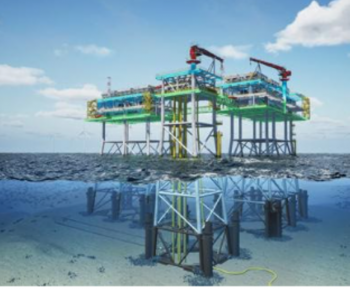
Friday, December 17, 2021
Tractebel and partner companies have developed the world’s first offshore infrastructure and processing facilities concept for the storage of hydrogen in offshore caverns. The design study, unveiled by Tractebel Overdick GmbH’s offshore experts, outlines an innovative solution for large-scale hydrogen storage on the high seas: a scalable offshore platform for the compression and storage of up to 1.2 million m³ of hydrogen.
Underground salt caverns will be used as storage and buffer for the hydrogen produced offshore, before the gas is transported via the pipeline network to the onshore grid and finally to consumers and customers.
Meeting the hydrogen demands of the future
Green hydrogen from offshore wind energy is becoming an important component of the global energy transition, but current hydrogen production technologies will only make an effective contribution if production rates reach an industrial scale. Enormous amounts of hydrogen (H2) from renewable sources will be required to supply future H2 energy demands and offshore sites are key to industrial-scale production. Tractebel pioneered an innovative solution to address this demand in 2019, with the development of a unique offshore hydrogen platform concept, followed by an optimised, scalable version the following year. And now, Tractebel’s experts break new ground with the design of the world’s first offshore infrastructure and processing facilities concept for the storage of hydrogen in offshore caverns.
Infrastructure for hydrogen production on the high seas
This offshore platform complex consists of a wellhead platform for the operation of the caverns and a series of compression platforms that enable a staged increase in capacity. If required, the plant can also be expanded in the future by additional modules. The study assumes a capacity equivalent to converting 2 GW of green offshore wind power into hydrogen. Extensions and individual adaptations are possible at any time.
Offshore compression and storage hubs such as these can further increase the flexibility of upcoming offshore hydrogen production. As the compression effort decreases at the wind farms’ electrolysis plants, so too shall the cost for offshore hydrogen production sites in general. “Centralized offshore hydrogen hubs also facilitate the integration of smaller-scale hydrogen production, which is to be expected within the scope of capacity expansions while re-powering offshore wind farms in the future. At the same time, they offer an economically viable option, as the export and compression of hydrogen produced offshore can be bundled. This significantly reduces the overall costs for future projects,” says Klaas Oltmann, Director Business Development at Tractebel Overdick GmbH.
For more information or the full release, visit Tractebel-Engie here